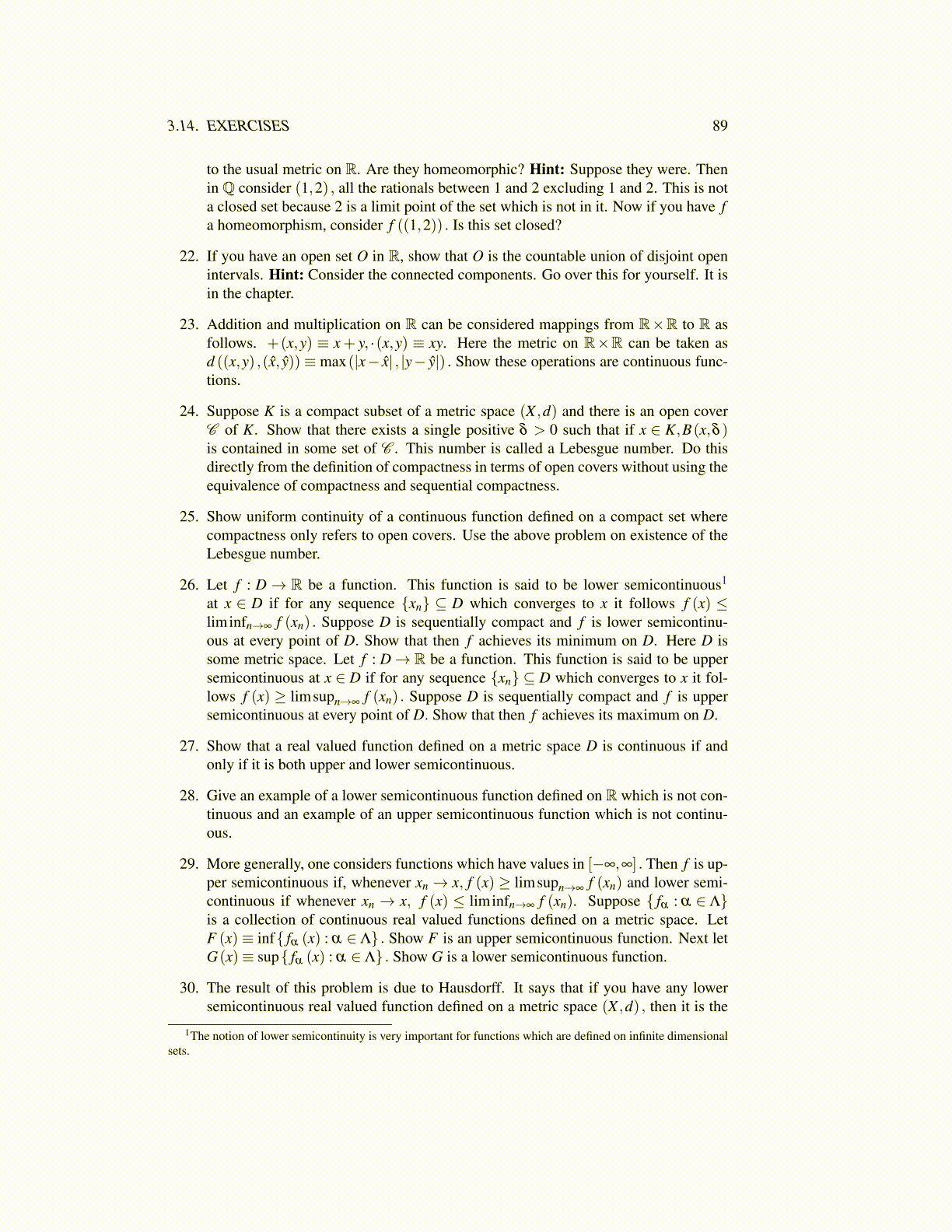
3.14. EXERCISES 89
to the usual metric on R. Are they homeomorphic? Hint: Suppose they were. Thenin Q consider (1,2) , all the rationals between 1 and 2 excluding 1 and 2. This is nota closed set because 2 is a limit point of the set which is not in it. Now if you have fa homeomorphism, consider f ((1,2)) . Is this set closed?
22. If you have an open set O in R, show that O is the countable union of disjoint openintervals. Hint: Consider the connected components. Go over this for yourself. It isin the chapter.
23. Addition and multiplication on R can be considered mappings from R×R to R asfollows. +(x,y) ≡ x+ y, ·(x,y) ≡ xy. Here the metric on R×R can be taken asd ((x,y) ,(x̂, ŷ)) ≡ max(|x− x̂| , |y− ŷ|) . Show these operations are continuous func-tions.
24. Suppose K is a compact subset of a metric space (X ,d) and there is an open coverC of K. Show that there exists a single positive δ > 0 such that if x ∈ K,B(x,δ )is contained in some set of C . This number is called a Lebesgue number. Do thisdirectly from the definition of compactness in terms of open covers without using theequivalence of compactness and sequential compactness.
25. Show uniform continuity of a continuous function defined on a compact set wherecompactness only refers to open covers. Use the above problem on existence of theLebesgue number.
26. Let f : D→ R be a function. This function is said to be lower semicontinuous1
at x ∈ D if for any sequence {xn} ⊆ D which converges to x it follows f (x) ≤liminfn→∞ f (xn) . Suppose D is sequentially compact and f is lower semicontinu-ous at every point of D. Show that then f achieves its minimum on D. Here D issome metric space. Let f : D→ R be a function. This function is said to be uppersemicontinuous at x ∈ D if for any sequence {xn} ⊆ D which converges to x it fol-lows f (x) ≥ limsupn→∞ f (xn) . Suppose D is sequentially compact and f is uppersemicontinuous at every point of D. Show that then f achieves its maximum on D.
27. Show that a real valued function defined on a metric space D is continuous if andonly if it is both upper and lower semicontinuous.
28. Give an example of a lower semicontinuous function defined on R which is not con-tinuous and an example of an upper semicontinuous function which is not continu-ous.
29. More generally, one considers functions which have values in [−∞,∞] . Then f is up-per semicontinuous if, whenever xn → x, f (x) ≥ limsupn→∞ f (xn) and lower semi-continuous if whenever xn → x, f (x) ≤ liminfn→∞ f (xn). Suppose { fα : α ∈ Λ}is a collection of continuous real valued functions defined on a metric space. LetF (x)≡ inf{ fα (x) : α ∈ Λ} . Show F is an upper semicontinuous function. Next letG(x)≡ sup{ fα (x) : α ∈ Λ} . Show G is a lower semicontinuous function.
30. The result of this problem is due to Hausdorff. It says that if you have any lowersemicontinuous real valued function defined on a metric space (X ,d) , then it is the
1The notion of lower semicontinuity is very important for functions which are defined on infinite dimensionalsets.